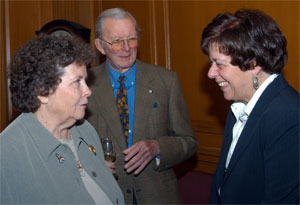November 15, 2004
Craig Chair surpasses $2 million funding goal
by Catherine Young
 | ||
| Dr. Susan Bryson holds the Jack and Joan Craig Chair in Autism Research.(Abriel photo) | ||
Dr. Susan Bryson, the first chairholder in the first endowed Chair on autismresearch in Canada, is a risk taker.
Three years after she became the Jack and Joan Craig Chair in Autism Research, her research group has expanded to include a lot of "the right people" - an administrator, researchers, post-docs and students."You've got to take risks and in the meantime, you've got to take theright people along with you," she says.
Bryson is, as Autism team member Dr. Isabel Smith says, "one of the foremost experts on autism in the world," she said. "First of all, she did the first North American study on the prevalence of autism - here in Nova Scotia. This has added an immeasurable amount to our knowledge." Recently, the Craig Chair surpassed its $2 million funding goal. In doing so, the Chair and its activities will be financially sustainable inthe foreseeable future.
For the one in 200 people in Nova Scotia who suffer from some degree of autistic spectrum disorder, diagnosis, research and treatment is anongoing need.
Bryson's team is now fully engaged in many exciting research initiatives. The first involves work on attention and emotion in children with autism. "We're going to monitor physiological factors like heart rate and skin response while children are attending to tasks, including tasks that elicit emotions," says Bryson. "We will check the attention, their emotional behaviour and the physiological responses that coincide." (ºÚÁϳԹÏÍøMedical Research Foundation generously donated equipment tomonitor the children in the study.)
The third project, which Smith calls "ground-breaking," is a comprehensive, multinational, multi-site study on infant siblings ofchildren with autism.
Autism is genetic. Because of this, siblings of autistic children are more at risk of being autistic than those with non-autistic siblings. "What we're doing is monitoring their development from six months of age," Bryson says."Knowing that some of them will develop autism, we're monitoring them forthe first signs ... and charting those signs out."
The goals of this research is to develop modules for front line physicians to use in practice. "Just to provide a context, most families - including families in Nova Scotia - spend two years trying to get someone to pay attention to them," Bryson says. "What we're doing is systemically document the earliest signs, make videos and modules and send them out to physicians and say, "If you see these signs, you have to refer these kidsfor an assessment for autism."
The group also wants to develop interventions for parents of newly diagnosed autistic children to use at home. They also want to create a database quantifying, for the first time, what the risk of having a secondautistic child is if there is already one in the family.
McMaster University, the University of Toronto/Sick Children's Hospital and Dal/IWK are Canadian partners in this research. The National Institutes of Health and the National Alliance of Autism Research in theUnited States is now assembling five American research sites.
Bryson and Smith have also recently started several other projects. Together with partners at McGill and McMaster, the duo will start tracking newly diagnosed autistic children from diagnosis to the first years of schooling. Additionally, Smith is working with David Westwood, of Health and Human Performance, to begin documenting the imitative behaviour of autisticchildren and how that relates to the acquisition of motor skills.
Finding ongoing federal and provincial financial support for autism research is a continuing challenge. But with the recent flurry of research activity and an influx of funding, Susan Bryson is optimistic that the Craig Chair can keep having a significant impact. "My real vision is that we will establish NS as a centre of excellence, both in research and in treatment. Of course, the ultimate goal is to advance the treatment of those with autism," she says. "There's a lot of work to be done, but there are a lot of people here who want to do the work."
